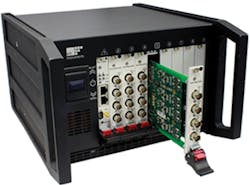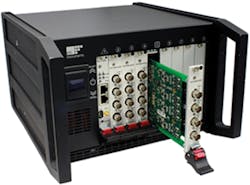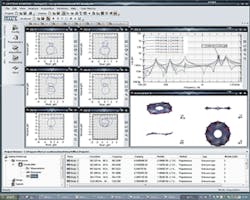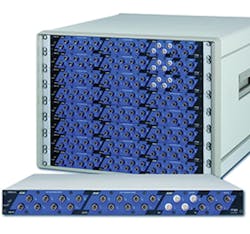Open Architecture Boosts Dynamic Signal Analysis
Data-acquisition systems using a range of architectures and connectivity options can perform a wide selection of signal acquisition and conditioning functions. Many vendors are addressing medical and health, military and aerospace, petroleum extraction, meteorological monitoring, industrial, and other applications with systems employing connectivity options ranging from USB to Ethernet and WLAN.
One company covered in last month’s report on DAQ1 recently developed a specific modular DAQ architecture. Based on PXIe and open software, the SentinelEX Series from VTI Instruments expands the company’s line of precision instrumentation into the medium channel-count and high-throughput application spaces, according to Tom Sarfi, vice president of business development.
VTI Instruments introduced members of the new series at the Society for Experimental Mechanics IMAC Conference last January in Jacksonville, FL. The initial products include the SentinelEX Series of “Smart” Dynamic Signal Analyzers (DSA). Sarfi said the new SentinelEX models represent VTI Instruments’ fourth generation of such analyzers and build on a legacy established in the 1980s of serving the noise, vibration, and harshness marketplace.
The new analyzers offer 625-kS/s/channel data rates; true differential inputs with common-mode rejection ratio (CMRR) better than -120 dB, reducing noise and interference; a spurious-free dynamic range (SFDR) better than -125 dB; and integrated electronic piezoelectric (IEPE) excitation flexibility, fully programmable from 2 mA to 20 mA, to maximize transducer performance and response.
PCIe to Ethernet
By means of a PCIe-to-Ethernet bridge, the series enables access to corporate-wide cloud data management to deliver advanced test-result availability, security, and storage services throughout the organization. In addition, open-platform FPGA-based synthetic-instrument customization extends traditional hardware performance by combining nearly unlimited user-defined computational, processing, and control possibilities.
The SentinelEX supports Mathworks’ industry-standard MATLAB and Simulink Software as well as other model-based design tools to simplify implementation, maximize reusability, and provide access to hundreds of standard filters and algorithms suitable for real-time distributed analysis. Hardware enhancements also include comprehensive runtime health monitoring and self-calibration without the need to disconnect external transducer cabling.
Added Sarfi, “With the release of SentinelEX, we are bringing the power of the worldwide web and cloud-based solutions—along with switched serial technologies (PCI Express), synchronized Ethernet (IEEE 1588), and model-based distributed processing—to the DAQ market. This is a natural evolution in test that began when we cofounded the now ubiquitous LXI platform for Ethernet-based instrumentation in 2004.” Utilizing IEEE 1588 (precision time protocol) ensures that test data is time-correlated, whether the instrumentation is centrally located or distributed around the device under test.
Courtesy of VTI Instruments
Sarfi said the SentinelEX can serve applications ranging from acoustics to machine-condition monitoring as well as general-purpose high-speed digitization and signal analysis.
Sarfi noted that at least 22 products in the series will roll out this year. Specific products introduced in January include a PXIe mainframe (Figure 1) as well as the EMX-2500 PXIe-Ethernet bridge; the EMX-4350, a four-channel, 625k-S/s, 24-bit smart dynamic signal analyzer; the EMX-4250, a 16-channel, 204-kS/s smart dynamic signal analyzer; and the EMX-1434, a four-channel, 204-kS/s, 24-bit arbitrary waveform source. The EMX modules complement the company’s line of SentinelEX general-purpose, temperature/voltage-measurement, and strain-measurement products as well as its lineup of VXI instruments (Table 1).
Courtesy of VTI Instruments
Software Support
Anirudh Narayanan, lead applications engineer at VTI Instruments, outlined the software support available for the SentinelEX hardware. “To complement the hardware, VTI is introducing a suite of software solutions for various DAQ domains. For general-purpose DAQ, we have launched EXLab, the next generation of our DAC Express software package.” EXLab, he said, is designed to be intuitive and easy to use while at the same time offering capabilities like advanced triggering, alarms, calculated channels, and a variety of data-visualization options. The software also is capable of implementing post-processing functions such as FFT.
Narayanan described a hardware feature of the EMX products with software implications. “Every plug-in module in the EMX Series incorporates a user-programmable FPGA, which offers a very high level of flexibility and computational power,” he said. The FPGA, he added, implements an AXI (Advanced eXtensible Interface) bus for which user-defined IP blocks can be connected to a virtual data bus without requiring any changes to the existing HDL code. “Users,” he said, “can configure the ‘smart’ data acquisition hardware by loading IP blocks on to the FPGA to perform user-defined filtering, signal processing, timing and triggering, and so on.”
As for the software implications, he said VTI selected a Mathworks-based environment supplying design tools in Matlab and Simulink that simplify algorithm implementation. “These tools,” he said, “provide an easy-to-use environment that allows even users with no HDL experience to develop IP blocks for the FPGA.”
The new VTI products support other software as well. For ground vehicle testing and modal analysis, Narayanan said, VTI is offering X-Modal III, a modal analysis software application featuring task-oriented user interfaces, modal-parameter estimation algorithms, parallel display capabilities, flexible data management, and channel expandability.
Based on the Mathworks’ MATLAB open-source programming environment, X-Modal III offers the capability to use leading-edge technology for modal testing. X-Modal III, Narayanan said, is developed by the Structural Dynamics Research Lab (SDRL), an expert in modal analysis, and is sponsored by test groups from The Boeing Company, Lockheed Martin, Sandia National Labs, CSA Engineering, and VTI Instruments. He added that it “…is already being used for some of the most complicated modal test applications in the world.”
Courtesy of VTI Instruments
In addition, Narayanan said, VTI is partnering with m+p international for its SO Analyzer Software (Figure 2), “which covers a broad range of DSA applications including modal, rotating machinery, shock/drop, and acoustics.” SO Analyzer supports third-party data import/export, data analysis, and reporting of results in a single package. It runs on a desktop PC or laptop and is designed for field, test-laboratory, and office applications.
Courtesy of m+p international
SO Analyzer supports a range of measurement hardware front ends in addition to VTI’s modules, including m+p’s VibPilot and VibRunner. The VibRunner platform (Figure 3), for example, accommodates dynamic measurement and shaker control applications requiring a large number of channels and high data throughput. Designed to be used with m+p’s VibControl and Coda Software as well as SO Analyzer, VibRunner serves in noise and vibration analysis, vibration testing, and dynamic data acquisition. The 19-inch mainframe houses up to three front-mounted modules and can be used stand alone or rack mounted. The system offers 24-bit resolution and up to a 102.4-kHz sampling rate. Multiple chassis can be distributed and synchronized using multiple Gigabit Ethernet interfaces.
Addressing Market Gaps
Narayanan explained what led VTI to design the SentinelEX family: “When we began development on this new product line, we sat down with many of our largest DAQ customers to try to understand what was missing from the current market offerings in this application space. In doing this research, we consistently found almost all of our customers have common goals across their organization, but fragmented solutions” when it comes to fulfilling their DAQ requirements. “Specifically, whether doing modal, static/structural, acoustic, thermal/environmental, or distributed/rugged measurements, they were typically using a unique hardware and software solution. They did this primarily because this was the only choice the market gave them,” he said.
Within each of these application spaces, the VTI engineer continued, “There typically have been one or two go-to vendors that offer a niche solution geared toward specific channel counts, measurement types, and desired sample rates. The end result from an organizational perspective is multiple solutions that need to be managed and maintained—driving up the cost and the complexity of the overall solution.”
Consequently, Narayanan continued, VTI’s high-level objective when designing the family of products was to offer a common platform that large organizations could standardize on, removing the need to maintain multiple solutions. Specifically, he said, one platform was needed that:
- Could address all physical measurement types and sample rates.
- Could scale up and down to efficiently address low, medium, and high channel-count requirements.
- Could address typical rack and stack applications as well as rugged/distributed measurement needs.
- Is supported by a wide variety of turnkey software solutions and development environments to provide a total solution regardless of the specific application.
The EMX mainframe implements an advanced switch fabric that facilitates data from plug-in modules being shared with each other directly instead of going through the host controller. This sharing allows extremely high-speed data transfers between modules and supports real-time applications and applications that require high-speed closed-loop control. In addition, the EMX mainframe is a multicomputing DAQ platform allowing any slot in the chassis to support what Narayanan called a root complex—that can be a processor, a memory unit, a GPU, and so on. Data from any slot can be streamed directly to any other slot for data processing or storage.
RESTful Protocol
The EMX Series firmware, Narayanan said, incorporates the RESTful HTTP protocol—based on the REpresentational State Transfer (REST) architectural style for distributed hypermedia systems. Narayanan explained the RESTful protocol allows instrument control using a standard HTTP interface.
“In addition to IVI drivers,” he said, “which permit application programming in a wide variety of development environments like Labview, C/C++, C#, and Visual Basic, the RESTful HTTP implementation allows the use of web programming languages like Java, PHP, Python, Ruby, and Perl.” The protocol, he said, offers capabilities beyond those typically found in traditional usage in the test-and-measurement industry. In fact, it allows users to easily develop web applications around the DAQ system, enabling truly remote capabilities. Data can be timestamped using a high-precision IEEE 1588 source, allowing the implementation of widely distributed data acquisition systems.
Narayanan also said the RESTful HTTP interface transforms the mainframe into a service that can be integrated with cloud databases and cloud computing services. For example, acquired data can be streamed to cloud services like Amazon EC2 or Microsoft Azure, where virtually unlimited processing power is available for data processing and analysis and data can be shared in a secured manner with any web-enabled device worldwide.
Narayanan concluded by noting that all EMX plug-in modules incorporate built-in self-test and run-time self-calibration functionality. “In addition, the EMX plug-in modules include the latest analog technologies to provide the highest accuracy results,” he said.
Open-Architecture Independence
SentinelEX embodies open technologies such PXIe and RESTful HTML as well as support for popular programming languages. It has been based on open-architecture design methodologies, resulting in a significant level of hardware and software independence. Industry-standard drivers and programming interfaces support all major programming environments.
You can configure your own system, providing your own software and even mixing and matching the EMX PXIe modules (or even PXI modules by making use of the hybrid slots). However, Narayanan noted, “the advantage of using a full VTI system is that customers would be able to use our Gigabit Ethernet PXI-to-LXI interface, making it very convenient for DAQ applications.”
You can purchase SentinelEX systems as complete turnkey solutions, incorporating open-source X-Modal III Modal Analysis Software and SO Analyzer Software, with full support provided through VTI. The approaches supported though VTI indicate some of the many flexible modular DAQ technologies from which you can choose. Our August special report will highlight others.
Reference
1. Nelson, R., “DAQ Technologies Support Broad Measurement Range,” EE-Evaluation Engineering, May 2012, pp. 20-24.




